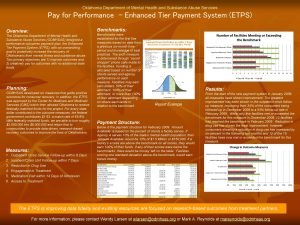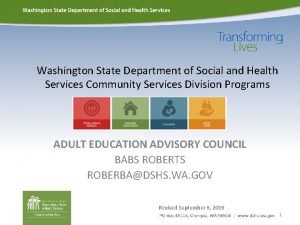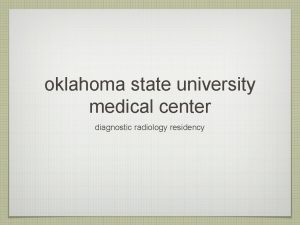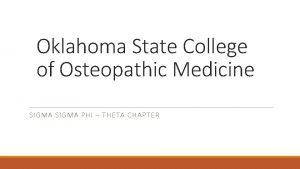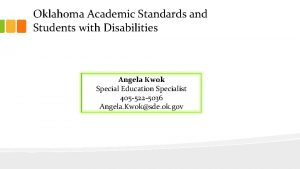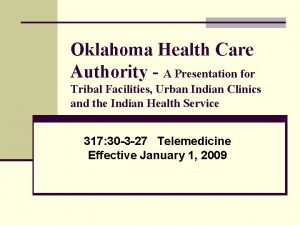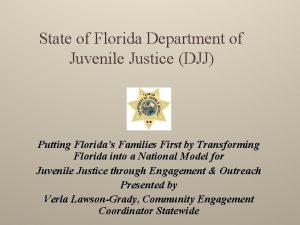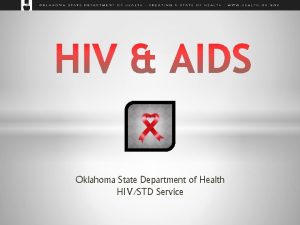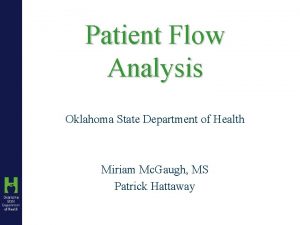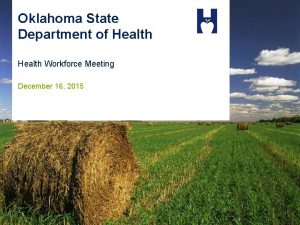Oklahoma State Department of Health HIVSTD Service 1





















- Slides: 21

Oklahoma State Department of Health HIV/STD Service

* 1. 2. 3. Minimal laughing and talking. 4. What we discuss in this room, stays in this room. It is not to be talked about on the playground or bus, around younger students, etc. 5. If you have a question you are not comfortable asking in front of the group or not sure if it is appropriate, catch me after class or your nurse when she is here. 6. If you are sitting next to someone who is going to make any of these a problem for you, now is a good time to move. No laughing at other student’s questions. If you are asking a question just to get a laugh or try to embarrass me, do not ask.

Human Immunodeficiency Virus • A virus spread through body fluids that affects specific cells of the immune system, called CD 4 cells, or T cells • A virus that kills the body’s CD 4 cells (T cells) and damages the immune system • A virus that replicates inside the human body, so it must invade a healthy cell in the body to survive

• AIDS is a late stage of the HIV infection • Once diagnosed, the body has hard time fighting disease and certain cancers • NO cure for AIDS, but there is treatment

• I can get HIV by being around people who are HIV positive. • I'm HIV-positive, now my life is over. • I would NOT be able to tell if my partner or I was HIV positive. • I can get HIV from oral sex. • I CANNOT get HIV from mosquitos. • My partner and I are both HIV positive, so there is no need to use a condom.

• In 2014, there were approximately 45, 000 new cases of HIV diagnosed in the United States. • In 2014, there were approximately 21, 000 new cases of AIDS diagnosed in the United States. • In Oklahoma, there approximately 6, 000 people living with HIV/AIDS. • The county in Oklahoma with the highest incidence of HIV/AIDS is Oklahoma county, Cleveland county is number three. • One in four new cases of HIV is diagnosed in the 13 -24 year old age group. • One out of eight people with HIV do not know they have the infection. • The age group with the highest rate of new AIDS cases is 20 -29 year olds. • Half of all people diagnosed with HIV have died.

Diagnoses of HIV Cases, by Age Oklahoma, 2015 N=317 United States, 2014 N=44, 073 3% 5% 5% 4% 12% 36% 19% 24% 15% 41% 25% 19 and Under Age 20 -29 Age 30 -39 Age 40 -49 Age 50 -59 60 and Over

HIV is passed from person to person through the exchange of body fluids 3 Ways: 1. Unprotected sex with People Living With HIV (PLWH) 2. Blood to blood contact 3. Exposure to HIV before or during birth or through breastfeeding

Blood Vaginal fluids Semen Breast Milk

Mouth Nose Eyes Ears Vagina Penis Anus Open Skin

Some people who have HIV may have NO symptoms for 10 years or more. It is estimated that 300, 000 -500, 000 people in U. S. have HIV, but do not know it. Symptoms vary from person to person. Some people who have HIV report having flu-like symptoms 2 -4 weeks after exposure.

The period of time after you may have been exposed to HIV, but before a test can detect it (up to 3 months) *IMMEDIATELY CONTAGIOUS*

What does the HIV Test Mean? Positive + Negative - • HIV virus found • Have the HIV virus • No HIV found • May not have HIV • Need to begin • Retest in 3 and can pass to others treatment (consider the window period) months

Newly Diagnosed? START TREATMENT! Treatment benefits: your own health & the health of others Thanks to better treatments, people with HIV are now living longer—and with a better quality of life—than ever before.

But, medication can be: Expensive - $30, 000 a year ($379, 668 lifetime) Complicated –different pills at specific times of day Toxic – side effects are common Ineffective – not all strains of HIV respond

Abstinence from Sex Abstinence from Injection Drugs Mutual Monogamy

REDUCED TRANSMISSION RISK Protected Sex Fewer Sexual Partners Never Sharing Needles Regular HIV/STD Testing

Condoms are 98% effective in reducing transmission rates if used consistently and correctly. Don’ts: • DON’T use expired condoms • DON’T unroll the condom before putting it on the penis • DON’T leave condoms in hot places (wallet, car, etc. ) • DON’T use oil-based products (baby or cooking oils, hand lotion, Vaseline, etc. ) as lubricants with latex condoms • DON’T use your fingernails or teeth while opening the condom wrapper. • DON’T reuse a condom or use more than one condom at a time (‘double wrapping’) Do’s: • DO keep condoms in a cool, dry place • DO throw the condom away after it’s been used

USE REFUSAL SKILLS S T O P SAY NO • Refuse to engage in unsafe behavior • Body Language Says “NO!” • Repeat Refusal TALK IT OUT • Use language that protects the relationship OFFER AN EXPLANATION PROVIDE ALTERNATIVES

Apps on your phone/device: • • “HIV Testing & Services Locator” “STD Testing Centers Locator” “Planned Parenthood Care” “HIV/AIDS Test” Websites that can help: https: //gettested. cdc. gov www. hivtest. org www. stdcheck. com www. gytnow. org www. aids. gov Local/County Health Departments: www. health. ok. gov

Resources HIV/AIDS Hotline: (800) 535 -2437 OSDH-HIV/STD Service: (405) 271 -4636 www. cdc. gov www. aids. gov www. health. ok. gov www. plannedparenthood. org www. sexetc. org www. stophiv. org
 Oklahoma state department of education standards
Oklahoma state department of education standards Oklahoma department of mental health
Oklahoma department of mental health Oklahoma department of career and technology education
Oklahoma department of career and technology education Oklahoma department of career and technology education
Oklahoma department of career and technology education Washington state department of social and health services
Washington state department of social and health services Louisiana health standards
Louisiana health standards Osu radiology tulsa
Osu radiology tulsa Oklahoma state college of osteopathic medicine
Oklahoma state college of osteopathic medicine Strrea
Strrea Oklahoma cooperative extension service
Oklahoma cooperative extension service Oklahoma health care authority
Oklahoma health care authority State of nevada department of business and industry
State of nevada department of business and industry State of nevada department of business and industry
State of nevada department of business and industry State of florida department of juvenile justice
State of florida department of juvenile justice State of alabama department of finance
State of alabama department of finance Texas state psychology program
Texas state psychology program Nysdot hdm chapter 5
Nysdot hdm chapter 5 University of iowa math department
University of iowa math department The state department us for
The state department us for Penn state meteorology certificate
Penn state meteorology certificate Jackson state university finance department
Jackson state university finance department State of nevada department of business and industry
State of nevada department of business and industry

